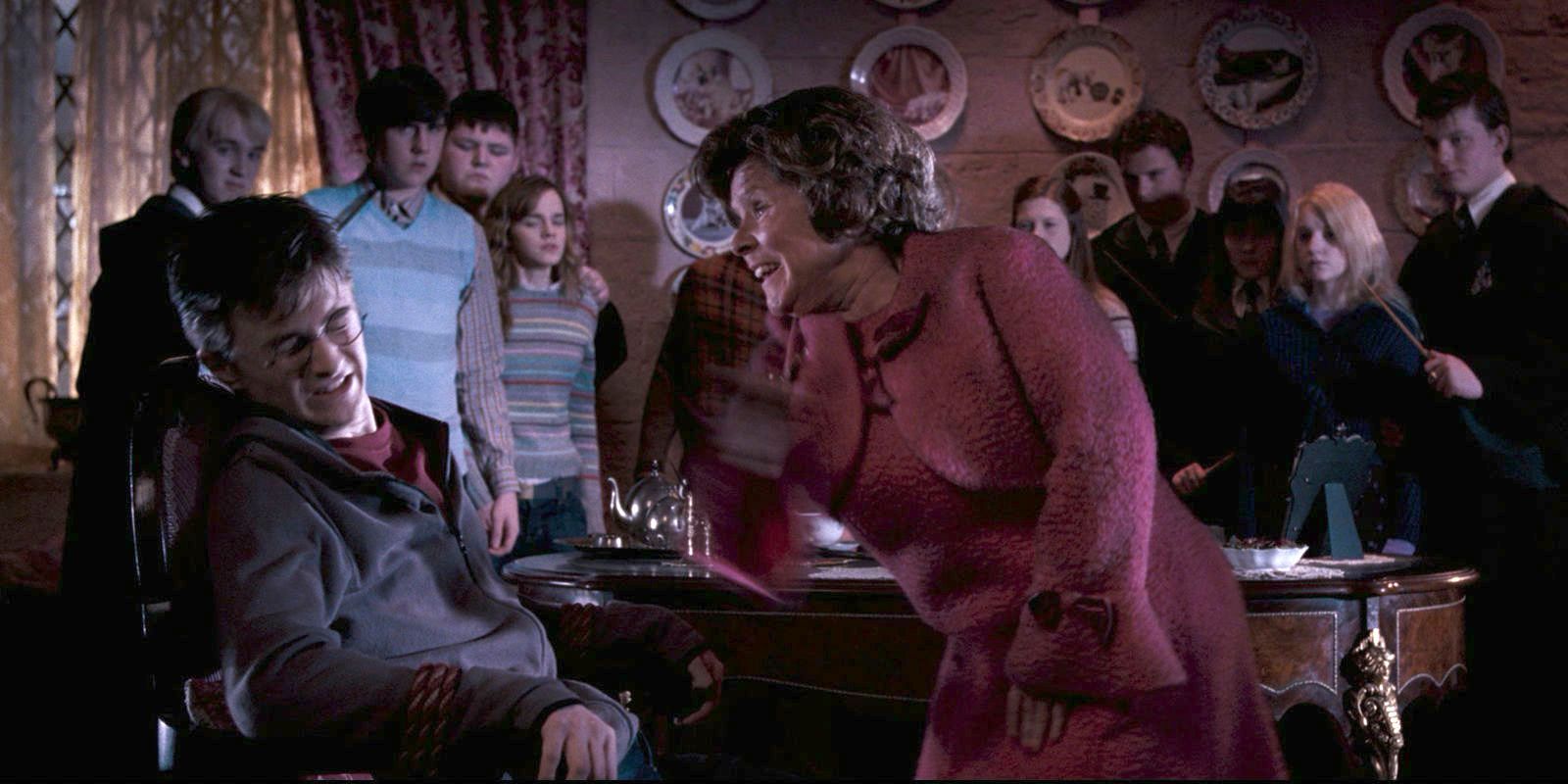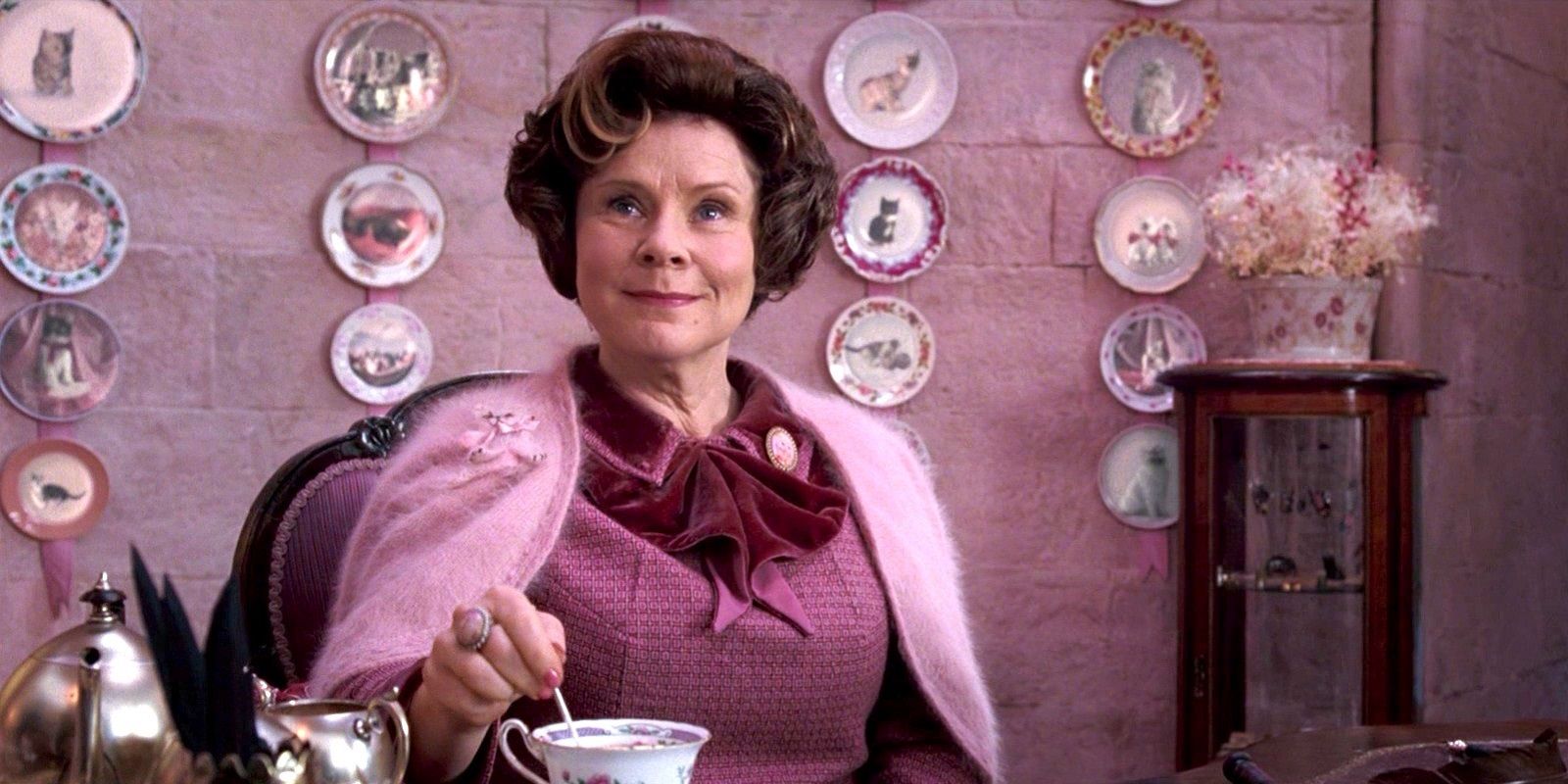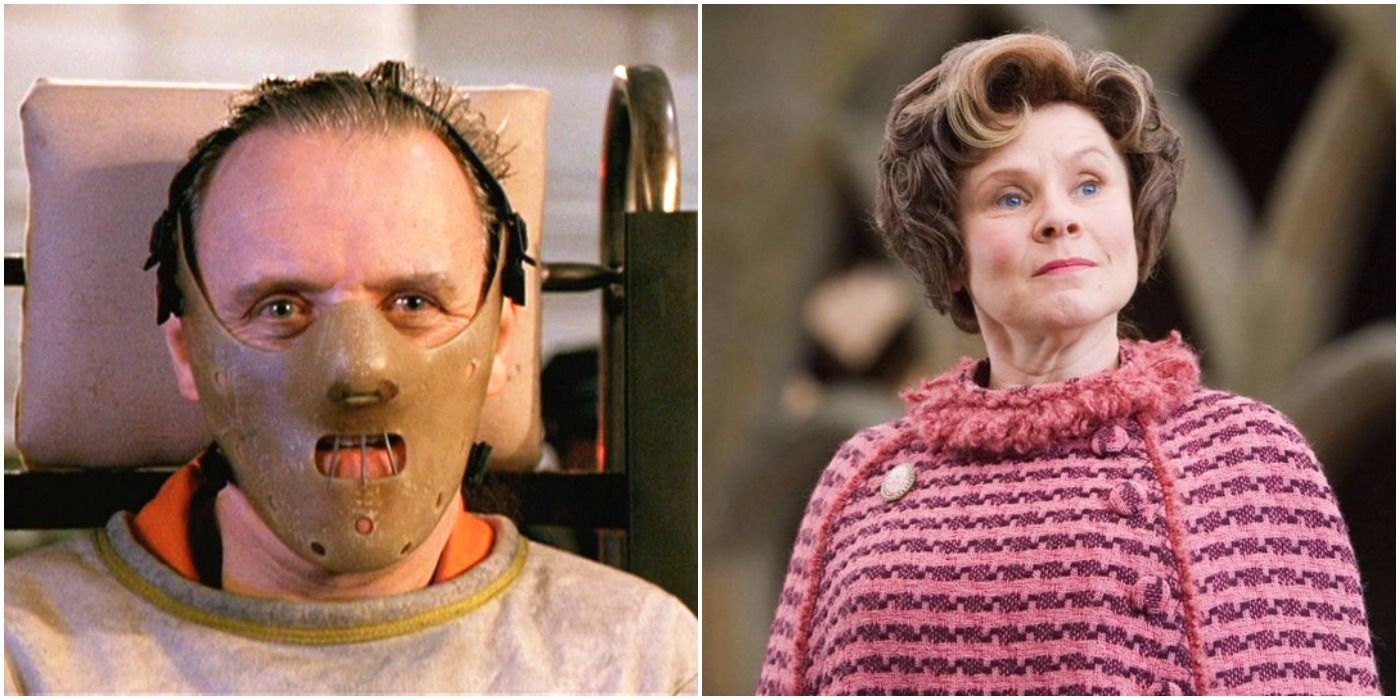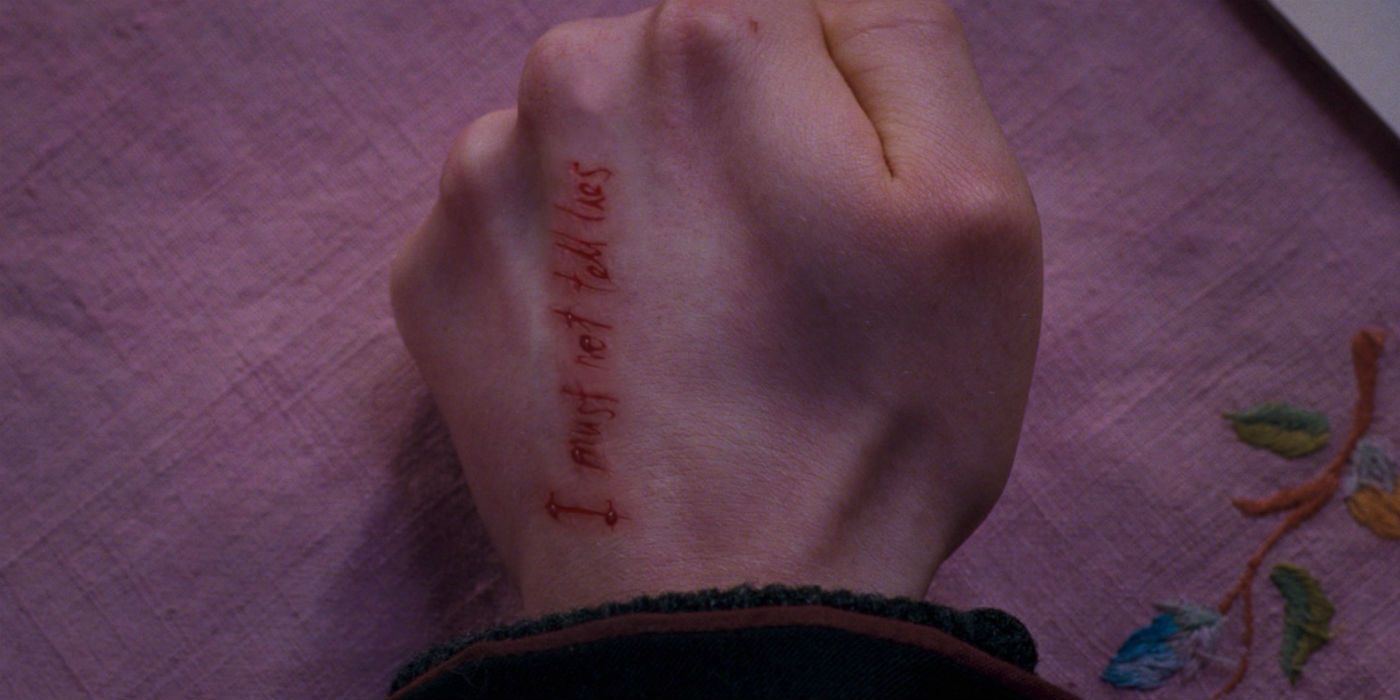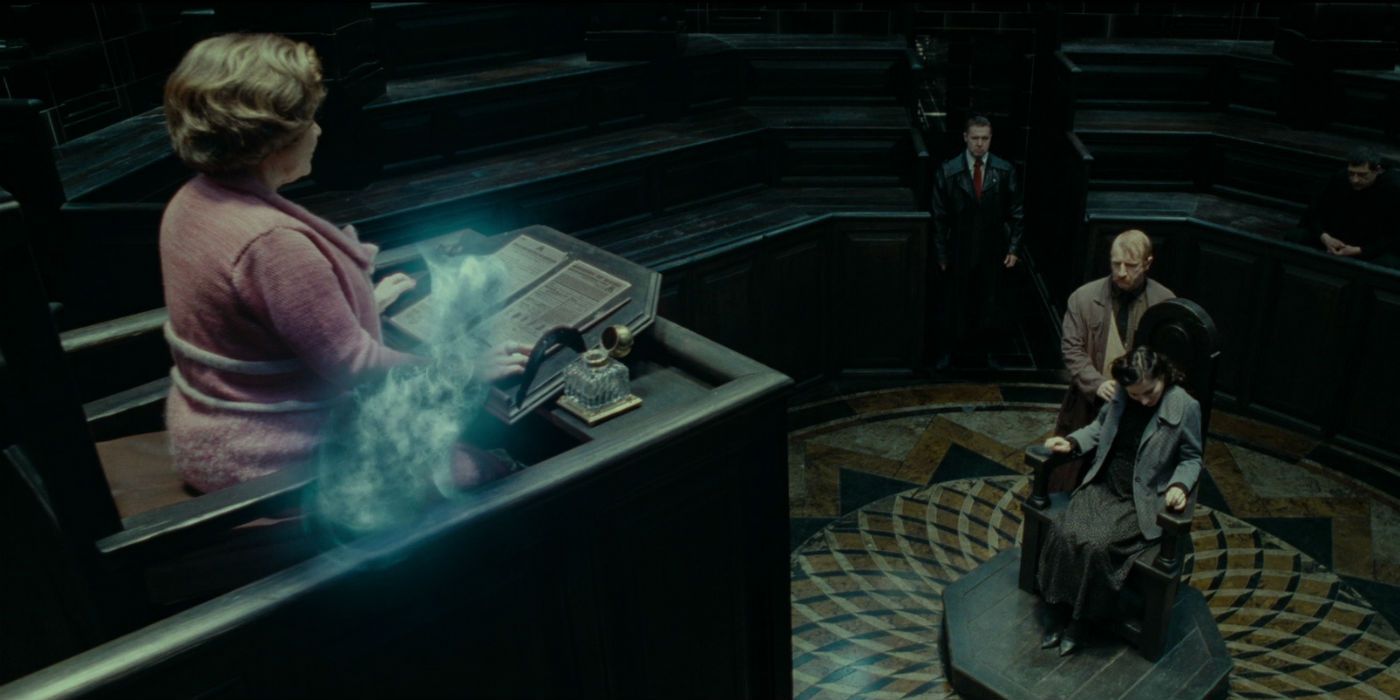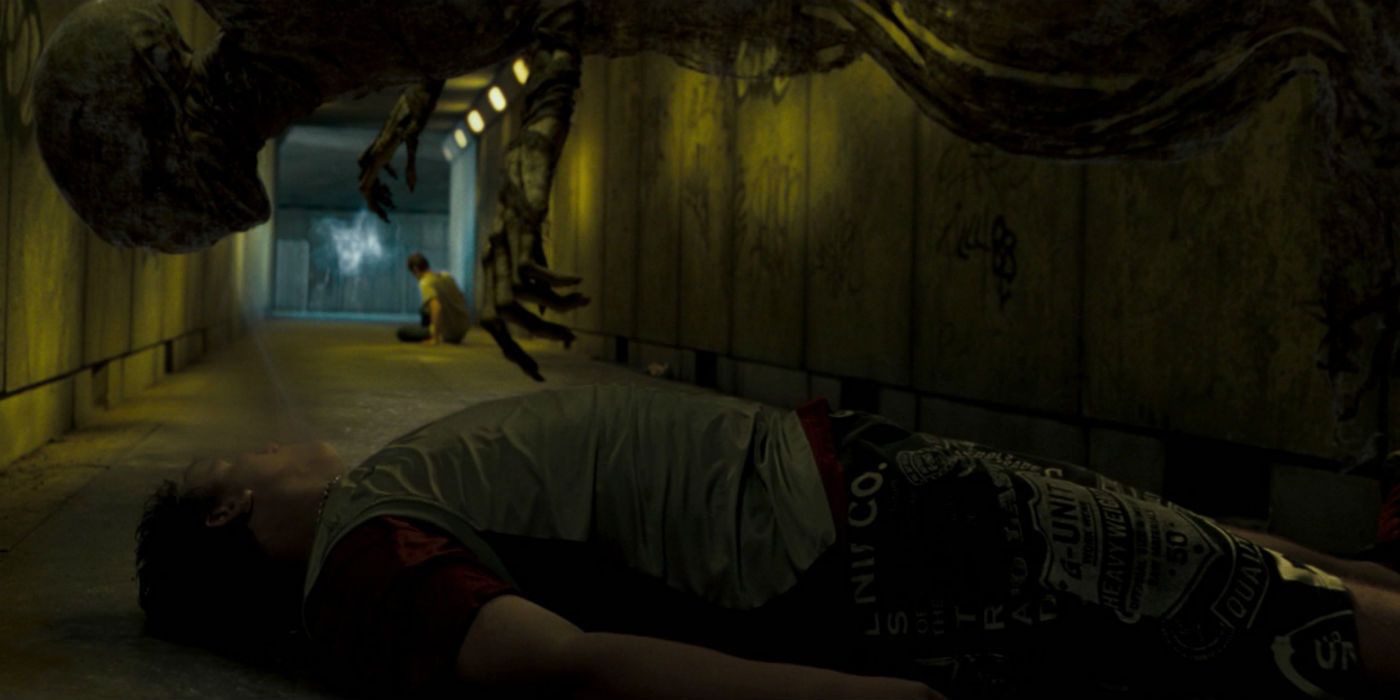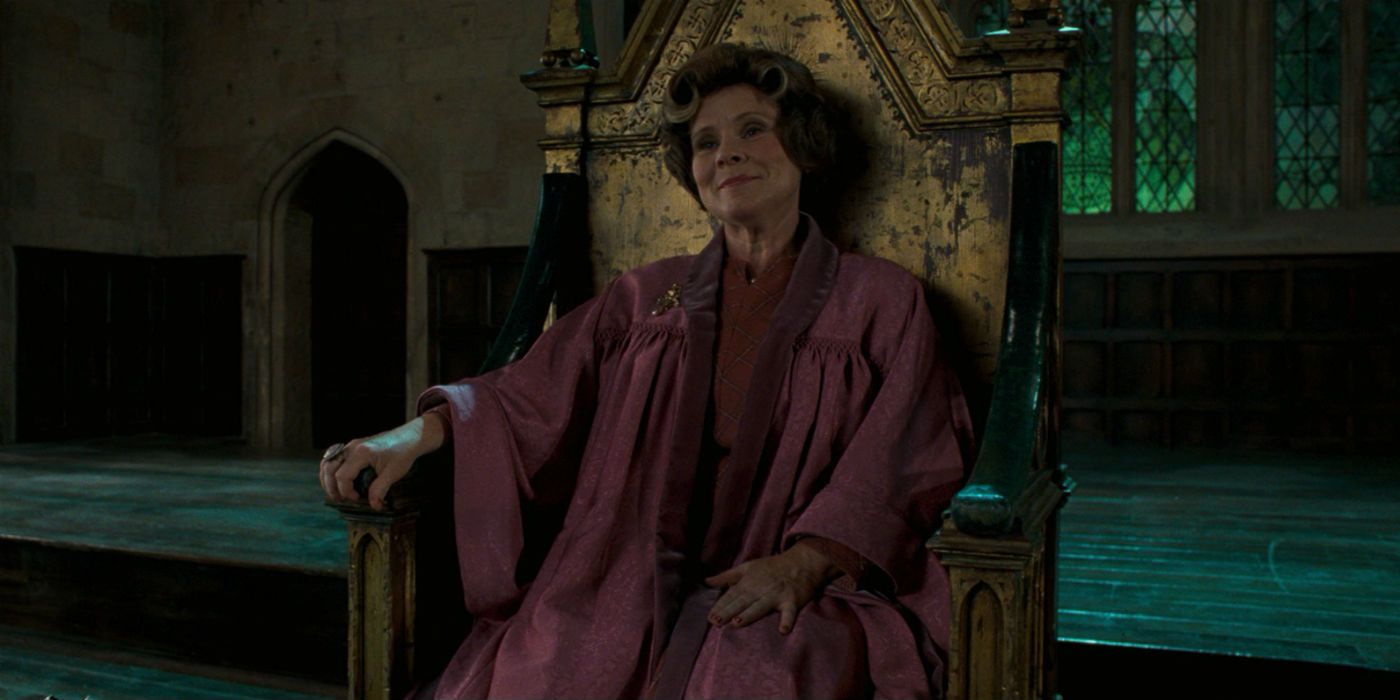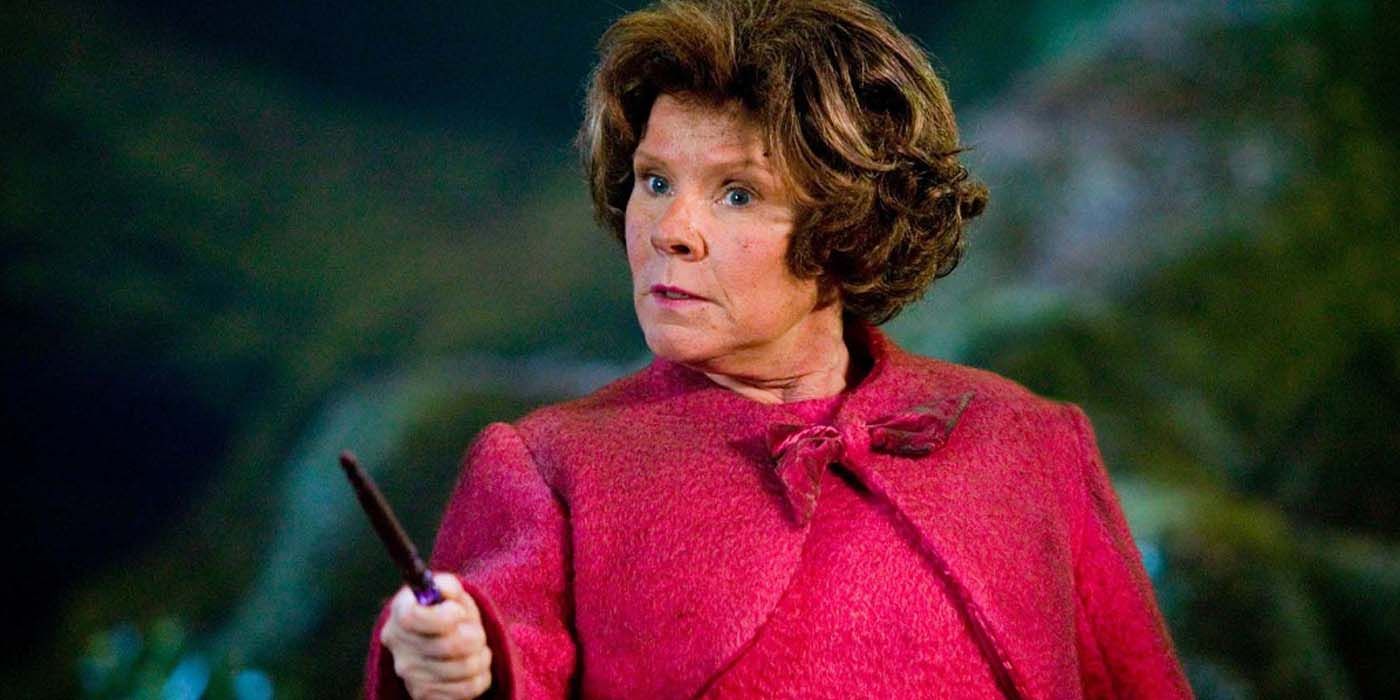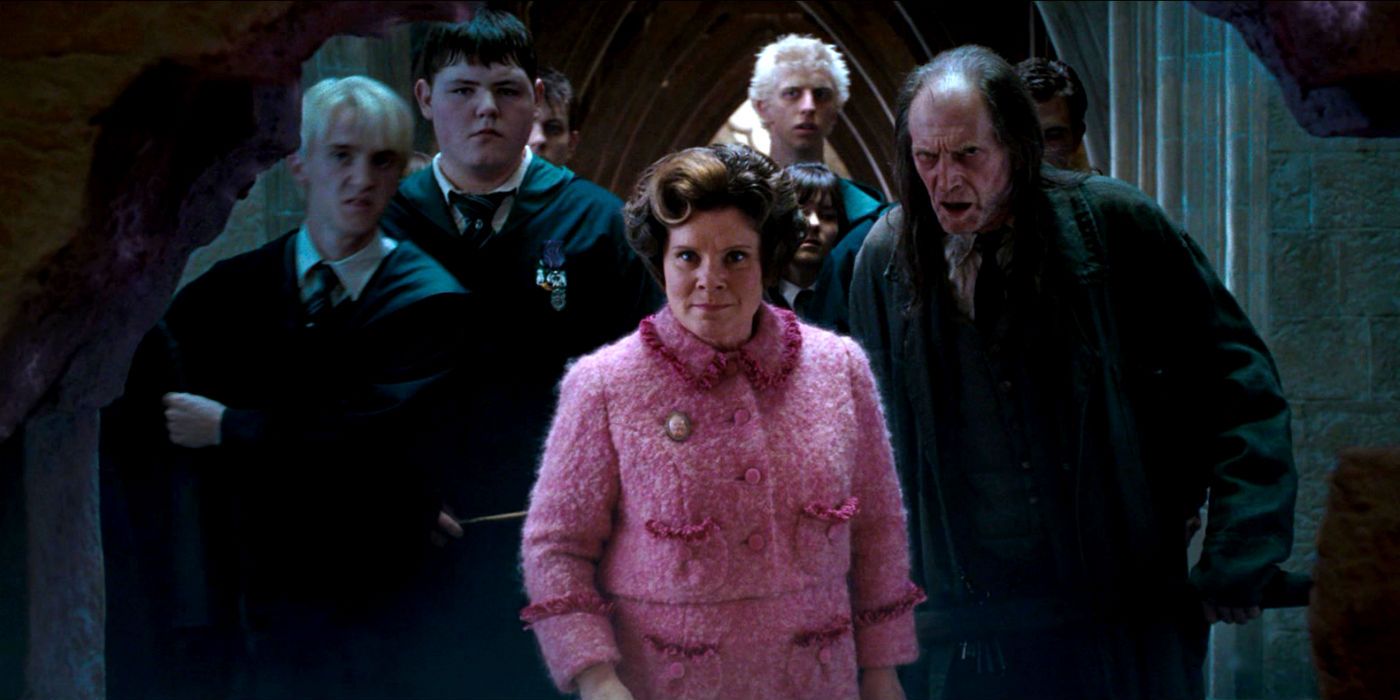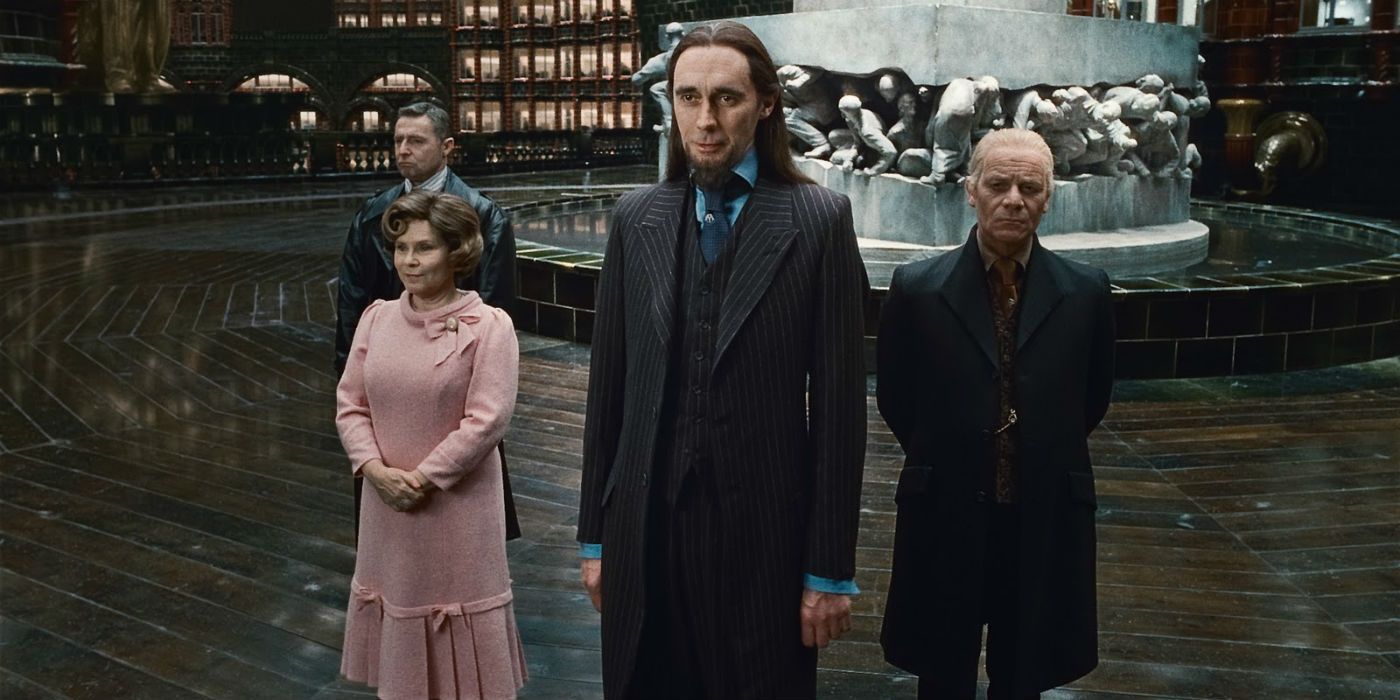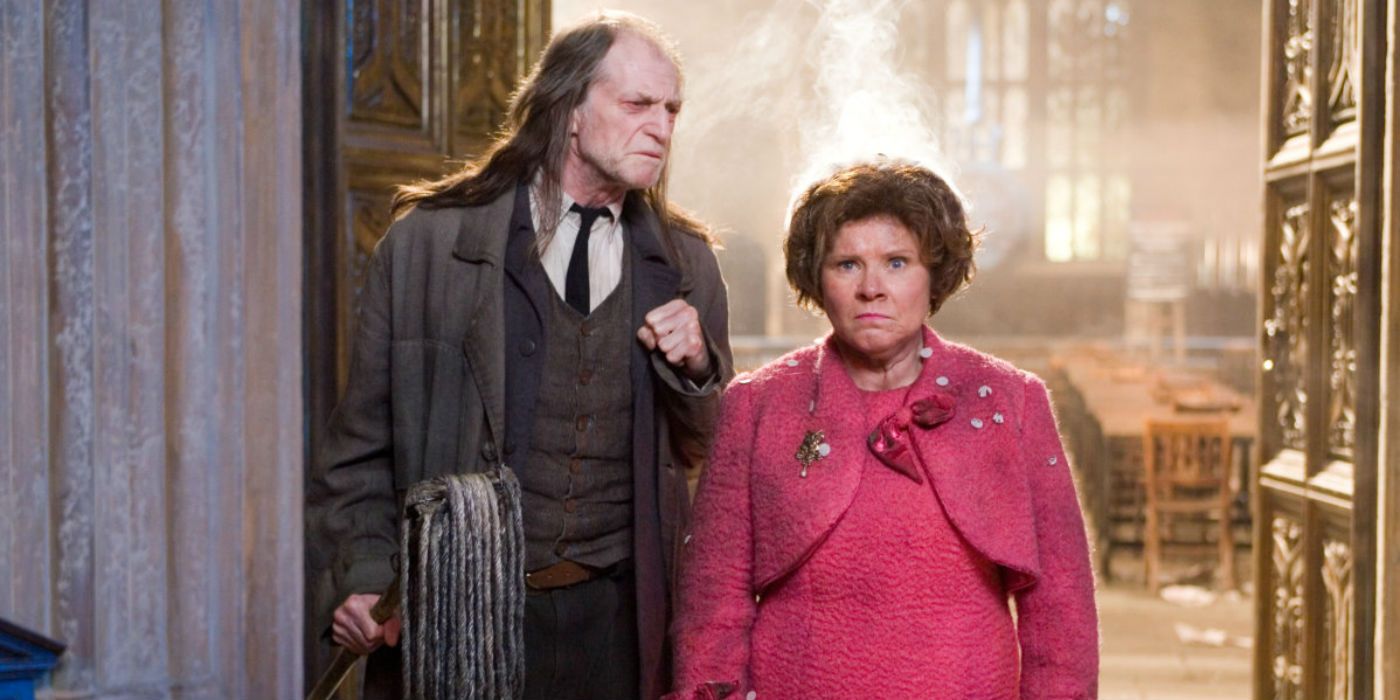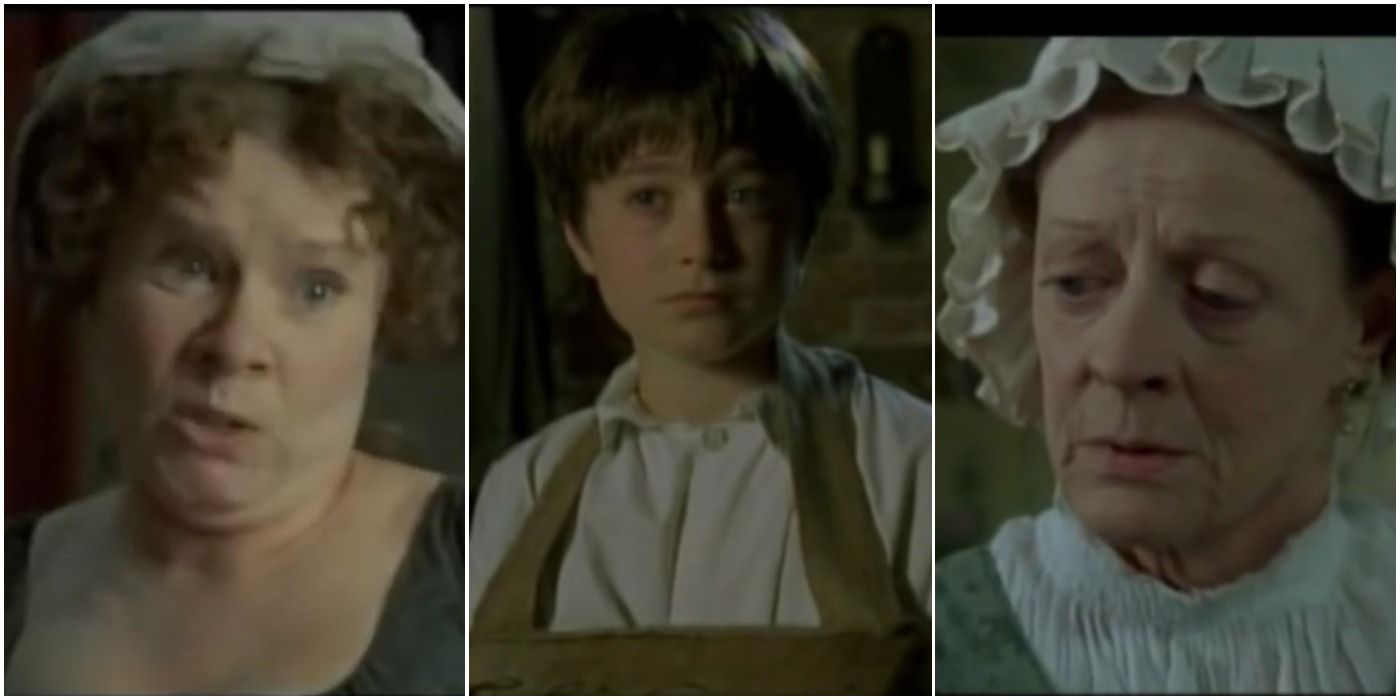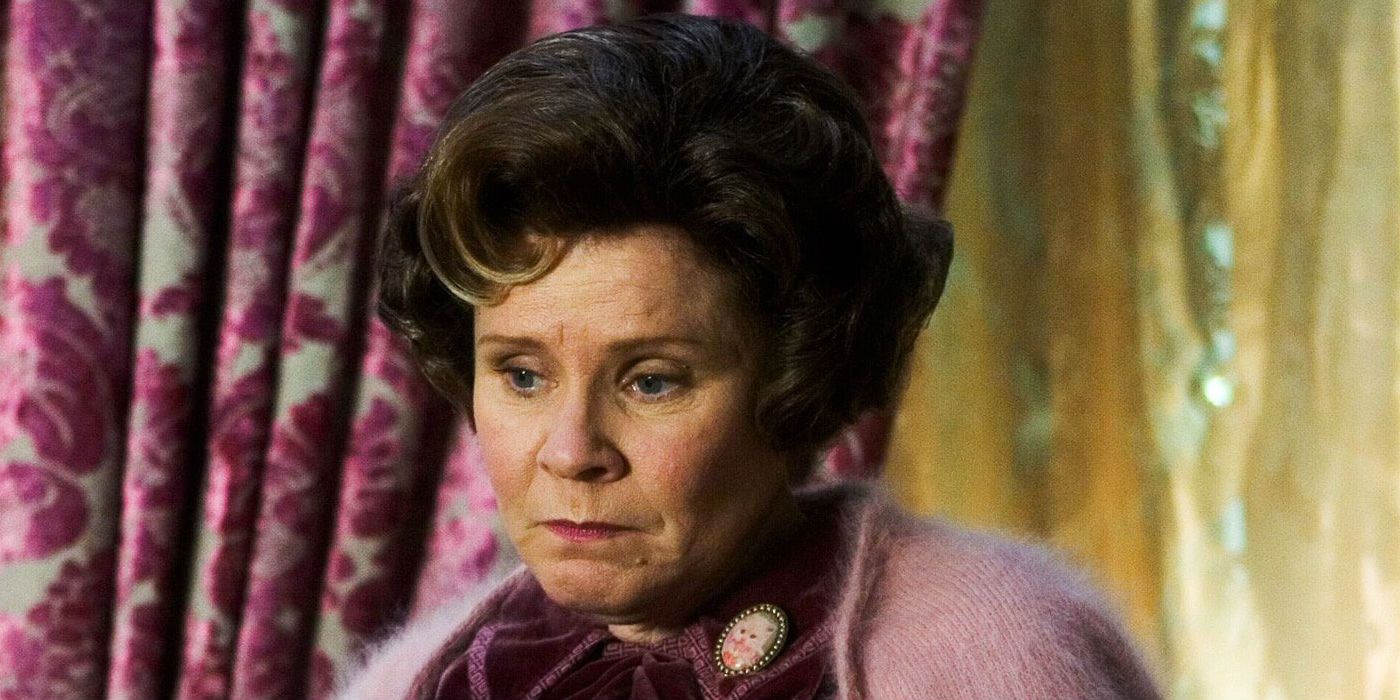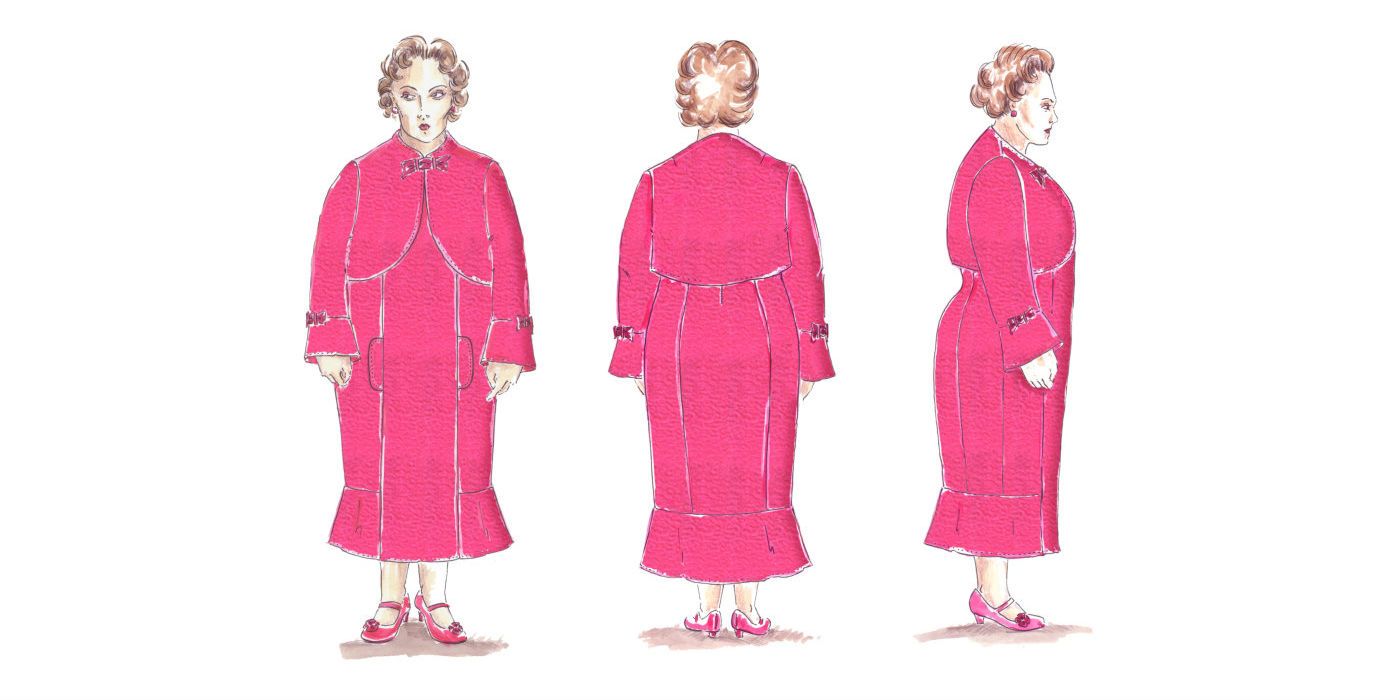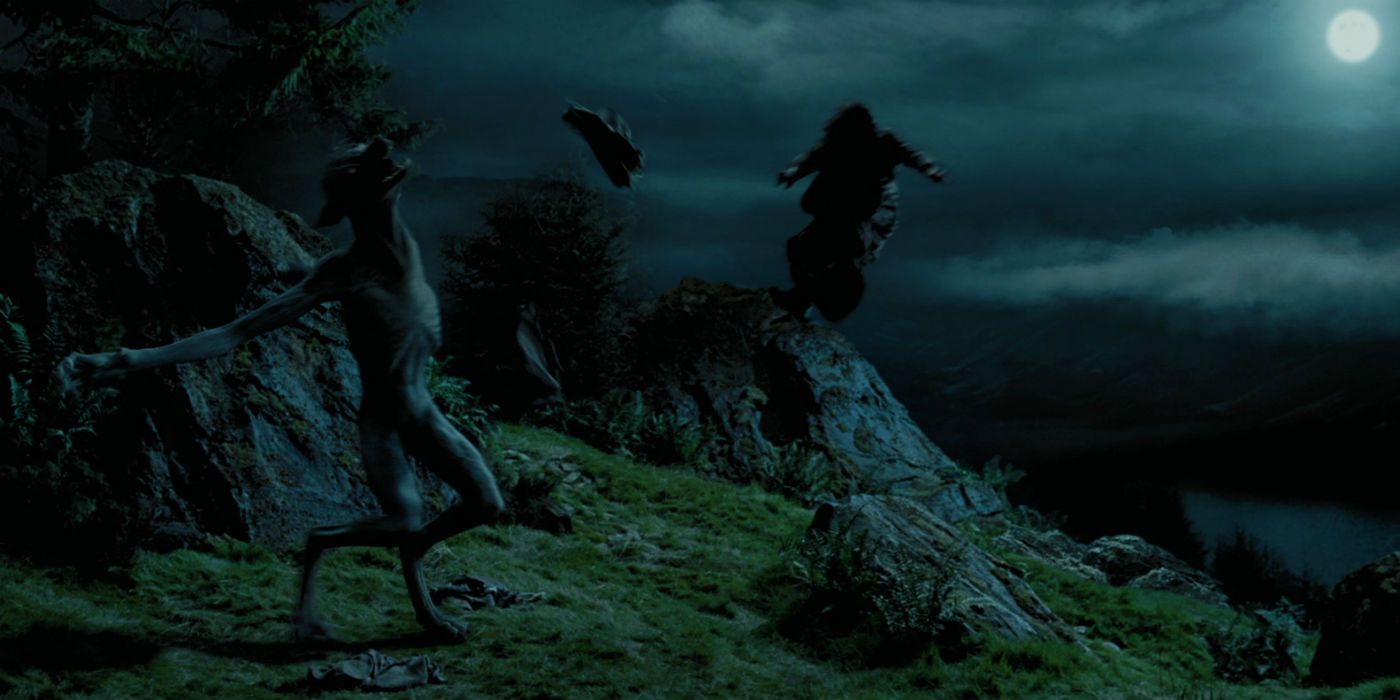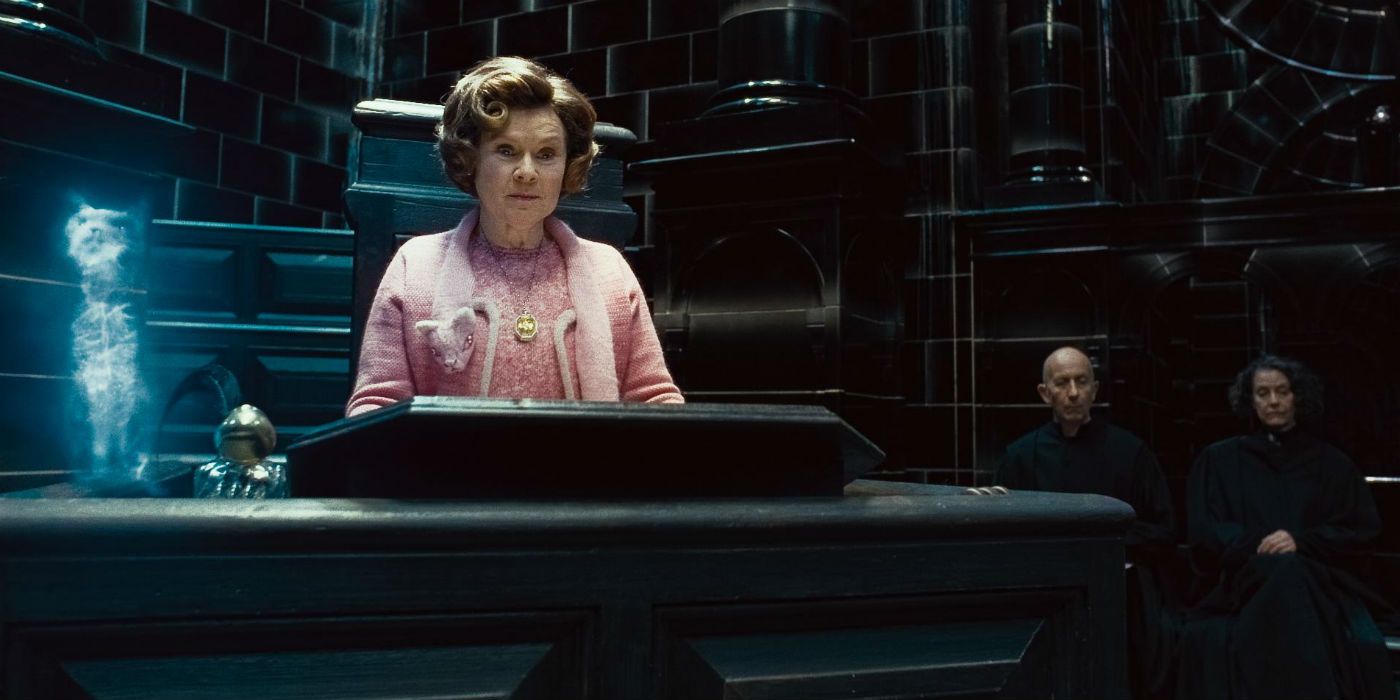Of all the horrible witches and wizards in the Harry Potter series, Dolores Umbridge is by far the one we all love to hate the most. With her sickening pink clothing, tacky obsession with cats, and cringeworthy 'ahems,' she makes our skin crawl and our teeth clench. There’s not one redeemable quality about her, but it’s her sinister misdeeds that make her stand out as a formidable villain in the wizarding world. Ask any Harry Potter fan who they'd Avada Kedavra first, if they ever got the chance, and Umbridge’s name would be at the top of the list.
While she was truly awful in the books, Imelda Staunton's version of Umbridge in the films has pushed her into the spotlight as one of the most despised characters in all of modern literature. Her tight-lipped, control-freak portrayal gave new life to the power-hungry witch who gets off on rules and corporal punishment. As such, it’s only fair that we dig deep and uncover 15 Things You Didn’t Know About Dolores Umbridge for your undoubtedly sadistic reading pleasure.
15. Stephen King thought she was the greatest villain since Hannibal Lecter
For the release of Harry Potter and the Order of the Phoenix, Entertainment Weekly wanted to have another famous author review the book. So, they hired the man who has over eighty adaptations of his own work to take a stab at the fifth book in J.K. Rowling's Harry Potter series. Stephen King gave Order of the Phoenix an 'A' and praised it for bringing us "the greatest make-believe villain to come along since Hannibal Lecter" -- only he wasn't talking about Lord Voldemort. King was referring to Dolores Umbridge, the new Defense Against the Dark Arts teacher introduced in this installation of the series.
"One needn’t be a child to remember The Really Scary Teacher, the one who terrified us so badly that we dreaded the walk to school in the morning, and we turn the pages partly in fervent hopes that she will get her comeuppance… but also in growing fear of what she will get up to next," he explains. We can all relate to having an authority figure in our lives that was just plain awful and inspired that little vengeful voice in all of us to come alive (as it often did for Harry and his fellow students at Hogwarts).
14. She's the only person, other than Lord Voldemort, to leave a permanent physical scar on Harry
It's also during Harry Potter and the Order of the Phoenix that we begin to see just how sadistic Umbridge actually is. As J.K. Rowling mentioned once on Pottermore, "Her desire to control, to punish and to inflict pain, all in the name of law and order, are, I think, every bit as reprehensible as Lord Voldemort's unvarnished espousal of evil." To punish Harry for saying that they needed to learn defensive spells to protect themselves against Lord Voldemort (when the Ministry of Magic had made it clear they didn't believe he had returned), she gave him a very unique form of detention.
Umbridge made Harry write “I must not tell lies” over and over again with a quill that had no ink. Instead, it was magically enchanted to use the writer’s blood, leaving a painful, inflamed scar on his hand. For weeks, he had to endure this rather Medieval form of torture while Umbridge relished in making her point via pain. In fact, Umbridge had created these torture devices, known as Black Quills, bewitching them with dark magic to keep children (whom she hated) in line. The fact that J.K. Rowling made her the only other person to leave a permanent mark on Harry besides the Dark Lord shows us what a truly evil person she really was.
13. She was responsible for the deaths of several people
Upon the release of Harry Potter and the Order of the Phoenix on Pottermore, J.K. Rowling wrote new material on Umbridge, including her life both before and after the events of the books. While we saw her intense hatred for Muggles, Muggle-Borns, and even magical creatures during the series, Rowling didn't get into the full impact of Umbridge's enforcement of these prejudices until the release of this supplementary material.
Apparently, as a result of the Muggle-born Registration Commission (which she headed up), many innocent witches and wizards were imprisoned in Azkaban, but unfortunately, some met their demise there. Rowling wasn’t specific about how they died, but we can speculate that if they weren’t sentenced to receive the Dementor’s kiss, they could have died of fright, a broken heart, or potentially suicide as well. Luckily, Umbridge herself was tried and sentenced to Azkaban for her crimes by Kingsley Shacklebolt when he became Minister for Magic after the fall of Lord Voldemort.
12. She sent the Dementors that attacked Harry and Dudley
While readers of the Harry Potter and the Order of the Phoenix book would know this information, it was conveniently left out of the film. As you might remember, at the very beginning of the film, Harry and his cousin Dudley are attacked by a pair of Dementors in an alley near their house. This was unusual, not just because it was a Muggle neighborhood, but because the Dementors were under strict control of the Ministry of Magic at that time.
When Harry had his trial for using magic in the presence of a Muggle, Dumbledore pointed out this very fact to the Wizengamot. He believed Harry when he asserted that he was attacked by Dementors and knew that it was no coincidence that they came after him. Although no one fesses up to it at that time, Umbridge makes it known that she finds it amusing that Dumbledore is basically accusing the Ministry of sicking the Dementors on Harry. However, after she catches the Boy Who Lived using her fireplace to communicate with Kreacher the house-elf, her toady face lets it slip that she was in fact the person who sent them after Harry. Perhaps the filmmakers left it out because the audience really didn't need any more reasons to hate Umbridge at that point.
11. She was the Headmistress after the Battle of Hogwarts in an alternate universe
If you haven't read Harry Potter and the Cursed Child and don't want any spoilers about it, skip this entry. For everyone else, read on! Believe it or not, Umbridge actually has the chance to be Headmistress of Hogwarts twice in the Harry Potter universe. During Harry Potter and the Order of the Phoenix, Dumbledore leaves Hogwarts after Fudge and the Ministry try to forcibly remove him. That leaves Umbridge, as High Inquisitor, to appoint herself as Headmistress in his absence. While she's definitely nasty in that universe, she's even more horrifyingly awful in an alternate universe created during the events of Harry Potter and the Cursed Child.
When Scorpius Malfoy and Albus Potter use the time-turner to try and save Cedric Diggory, they end up in another timeline of the present where Harry was killed (meaning Albus doesn't exist) and Umbridge is again Headmistress of Hogwarts following Lord Voldemort's victory during the Battle of Hogwarts. It's a terrifying reality where the screams of Mudbloods are heard throughout the school as they're tortured in the dungeons. Basically, it's everything Umbridge could have ever wanted as a Pure Blood crusader and twisted sadist.
10. Her wand: Birch, Dragon Heartstring, 8”
The composition of a witch or wizard's wand says a lot about their character in the Harry Potter universe. To those unfamiliar with the specifics of wand lore, allow us to break down Umbridge’s wand for you.
According to Ollivander, most wands fall between nine and fourteen inches in length. Anything shorter or longer than that is considered a rare occurrence, despite the height of the witch or wizard. Although Umbridge is described as a short, squat woman around five feet tall, the stubby length of her wand probably has more to do with Ollivander's explanation of why an abnormally short wand would choose a witch or wizard. According to him (and really, J.K. Rowling) "short wands usually select those in whose character something is lacking." No one would argue with that assessment of a person who takes pleasure in torturing children.
That’s also why the composition of her wand makes sense as well. While birch isn’t a typical wood, it was used for a corporal punishment called “birching” in which a bundle of birch twigs was whipped across the bare skin. That certainly fits into Umbridge’s character. In terms of her wand’s core, it’s one of the three “Supreme Cores” and is the most prone to the Dark Arts, which leads us to our next point.
9. She was a Slytherin, but not a Death Eater
While it was never mentioned in the books or films what Umbridge's Hogwarts house had been, apparently, a member of the Harry Potter Alliance (an activist group of Harry Potter fans) asked J.K. Rowling what it was at a book signing. Hypable reported that Rowling sorted her into Slytherin -- to the surprise of absolutely no one at all. Umbridge's backstory on Pottermore detailed her immense ambition, clawing her way to the top of any establishment she was a part of.
While she managed to make it to the top of Hogwarts, luckily, she never got so far as Minister for Magic. Nevertheless, when Lord Voldemort took control of the Ministry, and planted a Minister under the Imperius Curse, she was kept on for her similar ideals to the Dark Lord and his followers. However, she was never actually mentioned as a Death Eater, although she surely would have made a particularly nasty one. It’s likely she never stepped over that line for fear that Voldemort would find out she was a Half-Blood, which is ironic, because he was too.
8. She’s a Half-Blood
As mentioned above, Dolores Umbridge was, in fact, a Half-Blood. She, who was so intent on torturing Muggle-Borns and ensuring a Pure-Blood society, wasn't even from one herself. In the additional Pottermore writings released on her character, it's revealed that her father was a wizard and her mother was a Muggle. While that might have been embarrassing enough for some, Umbridge also had a Squib brother.
In general, Squibs live in a kind of limbo between the Muggle and wizarding world, since they can't do magic, but still have sensitivities toward it (like seeing ghosts and Dementors). Umbridge wanted nothing to do with either her mother or her brother, and when her parents split up, she remained with her father, never speaking to the other half of her family ever again. While Rowling never explicitly said that Umbridge's family inspired her cruelty and anti-Muggle sentiments, it's safe to assume that they did due to her estrangement from the non-magical side of her family.
7. Her father was a janitor at the Ministry
Speaking of Umbridge's father, she didn't care for him much more than the rest of her family. Sure, he was a wizard, but not a very ambitious one, unfortunately. All Orford Umbridge ever amounted to was working in the Department of Magical Maintenance at the Ministry of Magic. Basically, he was a glorified janitor.
Seeing as Dolores had high expectations for herself and (let's be honest here) illusions of grandeur, that would not do when she was asked about her father. No, he wasn't the man who used to mop the floors. According to Umbridge, her father had been a member of the Wizengamot (the wizarding world's high court). In fact, she basically paid him off so he would go away, allowing her to further perpetuate the lie that she came from a Pure-Blood family. To Dolores Umbridge, appearances were everything, and she refused to be associated with anyone who didn’t contribute in some way to her rise to power.
6. Imelda Staunton shared the screen with Daniel Radcliffe and Maggie Smith before Harry Potter
Many of the Harry Potter actors performed together before they became instantly recognizable for their appearances in the film franchise. One such occurrence was during a 1999 David Copperfield miniseries for the BBC. Both Imelda Staunton and Maggie Smith appeared alongside a nine-year-old Daniel Radcliffe, who was playing the young title character. It was his first onscreen role, and it came two years before he was cast as the Boy Who Lived. In fact, it was Maggie Smith who suggested him for the role of Harry Potter to producer David Heyman.
Staunton played Mrs. Micawber, the wife of Wilkins Micawber, David Copperfield’s landlord. She stuck by her husband despite his horrible financial decisions, nearly getting himself thrown into debtors prison. Emotional and kind, she’s just about as far from Dolores Umbridge as you can get. Not only is she married with multiple children, but she has such utter devotion to them that she’d likely faint in horror at the very thought of the things Umbridge did to her family.
5. Imelda Staunton really slapped Daniel Radcliffe in Order of the Phoenix
The scene in Umbridge's office during Harry Potter and the Order of the Phoenix is one of the most tense parts of the film. Harry and a number of the other Dumbledore's Army members are basically held at wand point by Umbridge and her Inquisitorial Squad, threatening them with all kinds of terrible things. Umbridge has been interrogating students using Veritaserum to find out if they've been collaborating with Dumbledore against the Ministry. She straight up asks Harry if he was going to Dumbledore, but when he denies it, she slaps him straight across the face.
Anyone who's seen that moment will agree the slap looks pretty darn real, and apparently, Daniel Radcliffe really did take one for the team. In an interview with Imelda Staunton, she revealed that she did, in fact, slap him, that they took multiple takes, and that "he was very brave." There's no way they would have tried that in one of the earlier films, but at that point, Radcliffe was around 17 or 18, so he could get slapped around without child protective services barking down their door.
4. Her name means “sorrow” and “to take offense”
J.K. Rowling never names anything without giving it a crap-ton of underlying meaning, and Dolores Umbridge's name was no different. According to Rowling, Dolores means 'sorrow' (alternately, aching or pain)—something she's good at inflicting on everyone around her. It actually comes from the Spanish title of the Virgin Mary, which says a lot about Catholicism, actually.
Umbridge, meanwhile, comes from an alternately spelled version of the word 'umbrage' and a British expression meaning 'to take offense.' She's also rather good at that, especially when people suggest that she's not actually Pure-Blood or threaten her authority. It can also translate to resentment from other languages like Spanish, which makes sense, considering how she felt like she got the short end of the stick in the family department.
You may or may not be aware that her middle name is Jane, but there's no real hidden meaning behind it. As Rowling explains on Pottermore, "it simply felt rather smug and neat between her other two names." Touché, Jo.
3. Imelda Staunton wore a padded bottom in the films
Costume designer, Jany Temime, who worked on six of the eight Harry Potter films, had a very strong opinion on Umbridge's look. Since she was described as short, squat, and toad-like, the design of Temime's costumes hid Imelda Staunton's legs as much as possible. Most of her outfits stopped mid-shin or around her ankles, and had a very boxy and unflattering shape.
However, Staunton wanted to take things even further. She insisted that Umbridge have a "noticeable derrière," which gave her a specific walk as she moved with it. It's highlighted especially well in the scene where the Weasley twins' firework dragon chases her out of The Great Hall.
Extra padding was also put into the front of the outfits to further emphasize her dumpiness. In fact, as Harry Potter and the Order of the Phoenix went on, her outfits became more padded and more restrictive while she gained more and more power.
2. Remus Lupin’s inability to find work was due to her anti-werewolf legislation
As you might imagine, Remus Lupin's lycanthropy (or werewolfism) was a bit of a social stigma. Werewolves were subject to fear and prejudice in wizarding society, especially by those obsessed with blood status. Even if a witch or wizard had come from a Pure-blood family, if they were infected by a werewolf in its transformed state, their standing in society instantly plummeted.
Lupin was always described as looking a bit tattered and worse for wear, but it wasn't just because he turned into a werewolf once a month. He was forced to live in poverty due to the fact that he had to change jobs frequently in order to ensure his secret wasn't exposed. After his time as the Defense Against the Dark Arts teacher at Hogwarts, his troubles were further exacerbated when none other than Dolores Umbridge introduced anti-werewolf legislation to the Ministry of Magic (Sirius mentions this to Harry during The Order of the Phoenix). This made it hard for someone like Lupin to find secure employment, as employers could effectively discriminate against werewolves because of their affliction.
1. She was the only villain to cast a Patronus
Despite the wickedness of her character, Umbridge was fully able to produce a corporeal Patronus. Her animal is a cat, ever watchful and secretive, striking out when threatened or undermined. No other villain or Dark-aligned witch or wizard was mentioned as being able to, or even desiring to, cast the protective spell. Why would they, when they recruited the very creatures the spell was meant to repel (Dementors) during the Second Wizarding War?
While it may seem strange for such a warped and twisted person to have the capacity to find a single moment of happiness and hope, there may be more to casting the charm than you think. According to Pottermore,"It may be that a true and confident belief in the rightness of one’s actions can supply the necessary happiness." Umbridge believed her deeds against Muggles and Muggle-borns were justified and necessary in order to cleanse wizarding kind. It's unknown what particular memory she focused on when creating her Patronus, but more than likely, it had to do with the moment she disowned her family and could live her life without constantly being reminded of their inferiority.
--
Do you know of any other fun facts about this wonderful all-around gal, Dolores Umbridge? Let us know in the comments.

